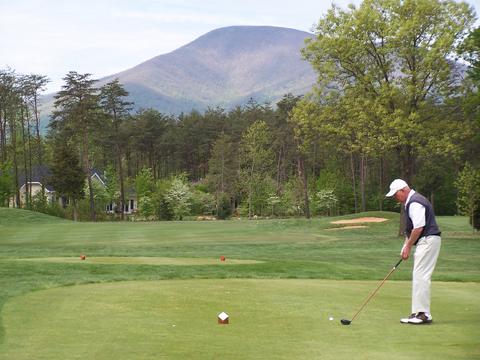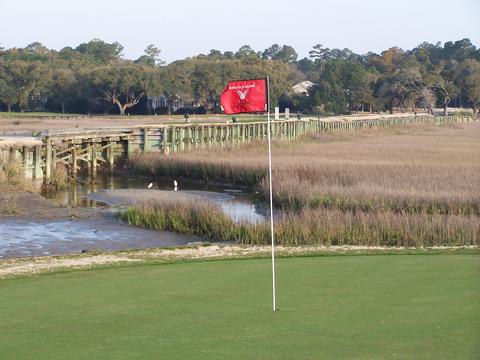It may not be related to global warming, but some folks in Georgia probably have Al Gore on their minds. More than half the state is suffering through the worst drought ever, the governor is upset with the U.S. Army Corps of Engineers for not stopping the flow of Georgia reservoir water to Florida, and golf courses in the Peach State are starting to show the affects. By some estimates, the city of Atlanta has about three months of drinking water left.
I am staying north of Atlanta, near Lake Lanier, and the headlines in all the local papers are about how the lake has become dangerously low. The Atlanta Journal-Constitution reported today that Georgia Governor Sonny Perdue has appealed to the U.S. Government for disaster relief and to stop the previously contracted flow of water from Lake Lanier to Florida, where it is needed to protect a population of endangered mussels. The governor and other legislators have gone after the U.S Army Corps of Engineers and the Department of Fish and Wildlife for "putting mussels ahead of people."
I drove around the Royal Lakes Golf Club course today following a group of collegiate golfers who will participate in the Oglethorpe College Royal Lakes tournament Monday and Tuesday. The course, just a few miles from Lake Lanier, was surprisingly green, but the lakes were low, water having been pumped from them onto the course. Some brown patches are starting to show, especially on the higher sides of the sloping fairways where there is more runoff. So far, the greens remain green.
In the Journal-Constitution today, a letter to the editor took local state officials to task for continuing to water the state-run golf courses in lieu of more attention to "native areas of our parks [that] encourage people to get their recreation through hiking, walking, biking..."
The lines are being drawn, and here's hoping the rain promised in the next few days is enough to still the accusations and help the golf courses, and mussels, survive.

From the first tee at Wintergreen's 27-hole Stoney Creek course, you know you are in for some special views. A second 18, the Devil's Knob, is on top of the mountain.
The latest issue of Travel & Leisure Golf (October 2007) highlights eight excellent southeast U.S. resort courses that stand out for autumn golf. All are either within golf course communities or close to residential areas.
We have played three of the eight and have the rest on our list for visits soon. The three we know offer a range of climates and amenities. As resorts, they make it easy to stay a week or more, "kick the tires" in the community to see if you like the course, the people and the local culture before making any long-term commitments.
The Wintergreen Resort is in the Blue Ridge Mountains of Virginia about 40 minutes west of Charlottesville. It isn't exactly in the sub-tropical belt, but some - especially skiers - will find the four-season climate part of the allure. We played two of the three nines at the Rees Jones-designed Stoney Creek course at the bottom of the mountain at Wintergreen; it was typical Jones, with well-placed bunkers of the tee and at greenside but a fair course all the way around. Residents told us that on some days in January, you can ski on the mountain in the morning and then drive down to the golf course and play in the afternoon (with a sweater on, of course). The other 18 at Wintergreen, called Devil's Knob, is an Ellis Maples design built on the very top of the mountain. Its first tee is a hundred yards from the terminus of the ski chair lifts. The course, which is closed from October to April, features some gorgeous mountain views and precarious edge of the mountain lies. For our extended previous review of Wintergreen as well as contact information, click here.
Pawleys Plantation also makes the T&L list, the magazine noting that Pawleys Island "is removed from Myrtle [Beach's] notorious crowds." Indeed, I maintain a second home at Pawleys Island largely for that reason; far enough away from the honky tonk beach atmosphere but close enough to take advantage of the more than 100 courses in the area. Pawleys Plantation, a muscular Jack Nicklaus design, is tough and beautiful, especially on the back nine as it makes its way out to the marsh. Pawley's 13th hole, a short par 3 that is all carry to a tiny green surrounded by marsh, is a sure par if you keep your ball anywhere on the green, and a sure bogey or worse if you don't.
My son and I still talk about our round at Cuscowilla almost two years ago. It is a most unusual course because of its "normal" layout; no modern affectations intrude on the natural feel and smooth routing of the layout. Bill Coore & Ben Crenshaw are best known for unfussy courses that
Other courses on the T&L list are Kiva Dunes on the Gulf Coast in Alabama, Callaway Gardens in Georgia, St. James Plantation in Southport, NC, the Inn at Palmetto Bluff in Bluffton, SC, and the Resort at Glade Springs, WVA. We hope to play them all in the coming year and report on them here and in the HomeOnTheCourse Community Guide.

The short 13th at Pawley's Plantation plays from a dike to a tiny green surrounded by marsh.
Page 877 of 1023























